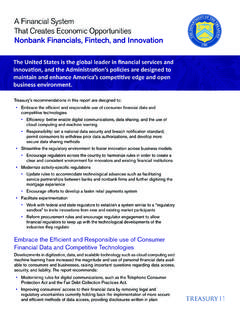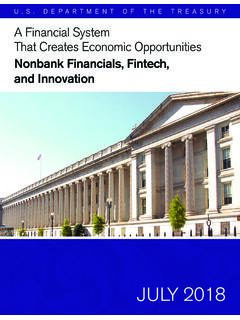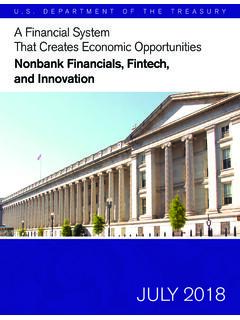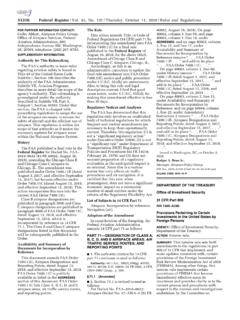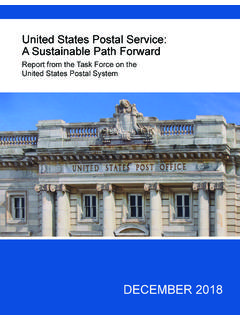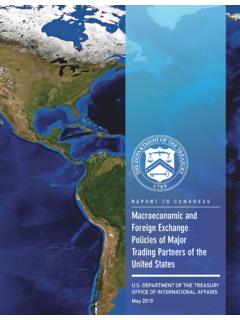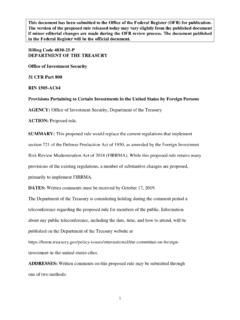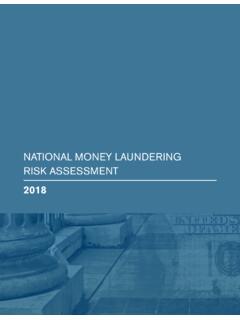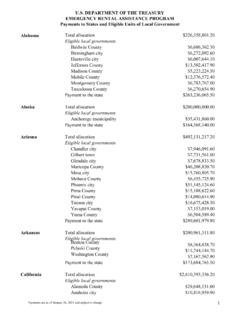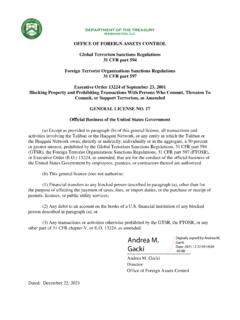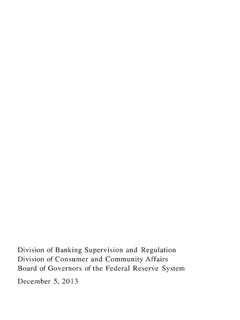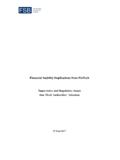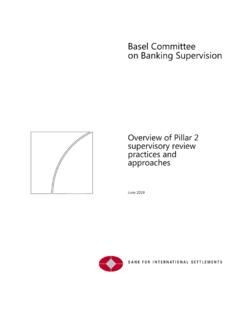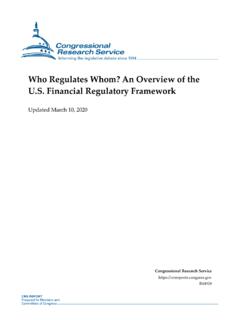Transcription of President’s Working Group on Financial Markets Statement ...
1 President s Working Group on Financial Markets Statement on Key regulatory and supervisory Issues Relevant to Certain Stablecoins This Statement provides an initial assessment from the President s Working Group on Financial Markets1 (PWG Members) on certain key regulatory and supervisory considerations for participants in significant digital asset arrangements that are designed to maintain a stable value relative to an identified fiat currency (so-called stablecoins ), have a nexus, and are intended primarily for retail payments PWG Members welcome dialogue on this Statement as authorities continue to assess the evolving technological and market landscape and regulatory framework with respect to stablecoins. The United States encourages responsible payments innovation. Digital payments, including dollar-backed and other stablecoin arrangements used as payment systems, have the potential to improve efficiencies, increase competition, lower costs, and foster broader Financial inclusion.
2 Digital payments systems, including stablecoin arrangements, should be designed and operated in a responsible manner that effectively manages risk and maintains the continued stability of the domestic and international Financial and monetary systems. Stablecoin arrangements must comply with applicable legal, regulatory , and oversight requirements. These requirements address a range of policy objectives, including safety and soundness, countering illicit finance, end-user protection, and market integrity. In particular, stablecoin arrangements with greater potential scale, complexity, and interconnectedness should consider and manage any heightened risks to participants, end users, and the broader Financial system. Stablecoin arrangements are expected to abide by the same requirements as other arrangements performing the same functions or activities, and posing the same risks, consistent with the general principle of same business, same risk, same rules.
3 Stablecoin participants and arrangements must meet all applicable anti-money laundering and countering the financing of terrorism (AML/CFT) and sanctions obligations before bringing products to market. In the United States, these obligations include registration with the Financial Crimes Enforcement Network (FinCEN); developing, implementing, and maintaining an effective anti-money laundering program (AML program); recordkeeping and reporting requirements, including suspicious activity reporting; and a tailored risk-based sanctions compliance program. The standards of the Financial Action Task Force (FATF) provide that AML/CFT and countering proliferation financing regimes apply to digital assets and their service 1 Executive Order 12631 of March 18, 1988 ( Working Group on Financial Markets ) established the President s Working Group on Financial Markets (PWG), which is chaired by the Secretary of the Treasury, or his designee, and includes the Chairman of the Board of Governors of the Federal Reserve System, the Chairman of the Securities and Exchange Commission, and the Chairman of the Commodity Futures Trading Commission, or their designees (collectively, PWG Members ).
4 The PWG also sought and considered the views of the Acting Comptroller of the Currency. 2 For the purposes of this Statement , stablecoins are the digital assets themselves. A stablecoin arrangement includes the stablecoin as well as infrastructure and entities involved in developing, offering, trading, administering or redeeming the stablecoin, including, but not limited to, issuers, custodians, auditors, market makers, liquidity providers, managers, wallet providers, and governance structures. 2 providers, including stablecoin arrangements. This includes requirements that both public and private sectors conduct adequate risk assessments to understand the risks posed by digital assets. Consistent with FATF standards, the United States regulates and supervises digital assets, including stablecoins and digital asset service providers on a functional basis under AML/CFT and sanctions regimes.
5 The United States further expects that compliance programs designed to meet these obligations are put in place before products are brought to market. Depending on its design and other factors, a stablecoin may constitute a security, commodity, or derivative subject to the federal securities, commodity, and/or derivatives laws. If so, the federal securities laws,3 and/or the Commodity Exchange Act ( CEA ),4 would govern the stablecoin itself, transactions in, and/or participants involved in the stablecoin arrangement. Whether a stablecoin is a security, commodity, or derivative will depend on the relevant facts and circumstances. Where a stablecoin that is primarily used for retail payments is adopted at a significant scale in the United States, the associated risks may require additional safeguards. We encourage relevant participants engaged in the design of such stablecoin arrangements and their functions, operations, transactions, and risk management to align with key principles, including: To facilitate Financial stability, stablecoin arrangements should be designed to address potential Financial stability risks posed, including large-scale, potentially disorderly redemptions and general business losses.
6 The stablecoin arrangement should have appropriate systems, controls, and practices in place to manage these risks, including to safeguard reserve assets. Strong reserve management practices include ensuring a 1:1 reserve ratio and adequate Financial resources to absorb losses and meet liquidity needs. dollar-backed stablecoin arrangements should hold high-quality dollar-denominated assets; hold these assets at regulated entities; utilize multiple custodians; and secure investments with high-quality obligors. To facilitate end user protection, consistent with fair and transparent Financial services, stablecoin arrangements should provide enforceable direct claims by holders against the issuer or the reserve assets, as applicable, to exchange their stablecoin, in a timely manner, for the underlying fiat currency 1:1 net of Stablecoin arrangements should clearly 3 The implications of this characterization, among others, are that offers and sales would be subject to the registration requirements of the Securities Act of 1933, intermediaries and other market participants would be subject to the provisions of the Securities Exchange Act of 1934, and issuers and other market participants may be subject to the provisions of the Investment Company Act of 1940 and the Investment Advisers Act of 1940.
7 The antifraud and anti-manipulation provisions of the federal securities laws also would apply. 4 The implications of this characterization, among others, are that offers and transactions in such derivatives may be subject to swap transaction-level requirements and intermediaries may be subject to various registration requirements in accordance with the CEA. In addition, such derivatives involving non-eligible contract participants must be conducted on or subject to the rules of a CFTC-registered designated contract market. The antifraud and anti-manipulation provisions of the CEA also would apply to any commodity transactions in interstate commerce. Further, certain retail commodity transactions may be treated as futures and subject to relevant requirements under the CEA. 5 The source of the ongoing direct payment obligation may vary depending on the particular stablecoin arrangement.
8 For example, it could be a direct payment obligation of the stablecoin issuer supported by unencumbered reserve assets or a direct payment right against the pool of reserve assets. 3 disclose the rights of stablecoin The claims procedure should minimize counterparty risks to the stablecoin holder, including by ensuring that the reserve assets are held in a bankruptcy-remote manner protected from other creditors of the stablecoin arrangement participants. There should be clear disclosures to promote transparency and informed choices for the end-user. These disclosures should include the stablecoin arrangement s operational and governance structures by, for example, providing a description of the functions and activities within the arrangement and who is accountable for those functions and activities, detailed Financial information supporting the backing of the stablecoin as well as any fees, foreign exchange risks, and potential conflicts of interest of entities involved in the arrangement.
9 Stablecoin arrangements should offer clear processes around error resolution, protect users from unfair or deceptive acts or practices, and protect user data. To facilitate market integrity, stablecoin arrangements must meet all applicable AML/CFT and sanctions obligations. Stablecoin arrangements designed to permit anonymous or pseudonymous transactions are likely to attract illicit actors and, without appropriate mitigation measures, allow evasion of key public policy objectives. Like other entities subject to AML/CFT and sanctions obligations, stablecoin arrangements must conduct identification and risk assessment of customers, monitoring of transactional activity, maintenance and provision of records to authorized parties ( , regulators and law enforcement) for AML/CFT purposes, reporting of suspicious activity, and screening for sanctions obligations, among other obligations.
10 Before products are brought to market, compliance features must be implemented by the providers subject to AML/CFT requirements within stablecoin arrangements to address these requirements and updated on an ongoing basis as circumstances change. Individual mitigation measures will vary, but they must include an assessment of risk, compliance with all regulatory and supervisory requirements, and effective AML/CFT compliance programs. In addition, stablecoin arrangements should have the capability to obtain and verify the identity of all transacting parties, including for those using unhosted wallets. To facilitate operational resilience, stablecoin arrangements should apply robust risk management frameworks. Stablecoin arrangements should ensure a high degree of security and operational reliability, including cybersecurity, and should have adequate, scalable capacity.
